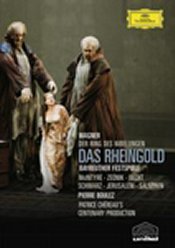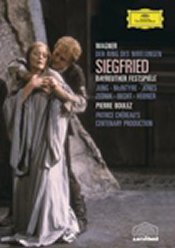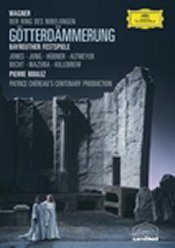Videos of the production have been available for many years, and certain detailsósuch as the hydroelectric dam which functions as the setting for the Rhinemaidensí scenes in Das Rheingold and Gˆtterd‰mmerungóhave become almost legendary. Few, if any, of those who purchase this DVD set will be shocked by its contents, and there might be a tendency to regard this recent re-release as simply another re-packaging of familiar material. And yet it is this very familiarity that is so significant. If 1976 marks the appearance of the postmodern Ring, 2006 marks a different moment, in which post-modernism itself becomes historical.
In the most general sense, ChÈreauís production of the Ring can be called ìneo-Shavian.î Like Bernard Shaw in The Perfect Wagnerite, ChÈreau interprets the Ring not so much as an amalgam of Nordic mythology and medieval legend, but as a parable about industrialism. From the plush costumes of the gods in the second scene of Das Rheingold to the oversized iron flywheel that haunts the first act of Siegfried, ChÈreauís production is replete with references to the nineteenth century. These references operate powerfully on the contemporary viewer/listener. Unlike what we can call the ìneo-realistî materials of the Otto Schenk/G¸nther Schneider-Siemssen production (which has dominated the stage at the Metropolitan for two decades), the detritus of nineteenth-century industrialism is still a part of our visual environment: the references therefore seem both historical and contemporary. Through his collage-like use of these visual materials ChÈreau simultaneously locates the Ring in the nineteenth century and in our own time.
 This vision seems clearest in Das Rheingold. ChÈreau takes full advantage of Wagnerís ìanvil musicî in the Nibelheim scene. Alberichís minions look as if their bodies have been distorted by inhuman work in underground mines. The gods in the second and fourth scenes look not so much costumed as upholstered. If there is any problem with their appearance, it is that they look too decadent, too ripe for destruction. Only Donald McIntyreís Wotan asserts the tragic dignity of the godsí situation. Resisting the urge to let the voice fully bloom in the majestic music that opens the second scene (ìVollendet, das ewige Werk . . ì), McIntyre presents a Wotan thatófrom his first appearanceóis deeply conflicted. His lower range may lack some of James Morrisís authority, but McIntyre is a skillful singer and a consummate actor who fully inhabits his role. He carries Das Rheingold, and much of the rest of the Ring as well.
This vision seems clearest in Das Rheingold. ChÈreau takes full advantage of Wagnerís ìanvil musicî in the Nibelheim scene. Alberichís minions look as if their bodies have been distorted by inhuman work in underground mines. The gods in the second and fourth scenes look not so much costumed as upholstered. If there is any problem with their appearance, it is that they look too decadent, too ripe for destruction. Only Donald McIntyreís Wotan asserts the tragic dignity of the godsí situation. Resisting the urge to let the voice fully bloom in the majestic music that opens the second scene (ìVollendet, das ewige Werk . . ì), McIntyre presents a Wotan thatófrom his first appearanceóis deeply conflicted. His lower range may lack some of James Morrisís authority, but McIntyre is a skillful singer and a consummate actor who fully inhabits his role. He carries Das Rheingold, and much of the rest of the Ring as well.
 The first act of Die Walk¸re preserves the voice of Peter Hofmann (as Siegmund) before his rapid vocal decline. His undeniable beauty and physical vigor make him a charismatic presence, even if his singing lacks some of the nuance that other tenors have brought to the role. By casting Hunding as a wealthy nineteenth-century merchant, and having him enter with an intimidating group of retainers, ChÈreau underscores the danger that Siegmund faces. Indeed, Matti Salminenís Hunding is so menacing that it is hard to imagine that Siegmundóeven with the help of his magic swordówill stand a chance against him. Hofmann also seems to be overshadowed by the Jeannine Altmeyerís Sieglinde. Altmeyerís voice is absolutely radiant, and she brings a sense of urgency to the role that at times borders on frenzy. In part because of her energy, the first act of Walk¸re is perhaps the most successful part of the Boulez/ChÈreau Ring, in which musical and dramatic values completely support each other.
The first act of Die Walk¸re preserves the voice of Peter Hofmann (as Siegmund) before his rapid vocal decline. His undeniable beauty and physical vigor make him a charismatic presence, even if his singing lacks some of the nuance that other tenors have brought to the role. By casting Hunding as a wealthy nineteenth-century merchant, and having him enter with an intimidating group of retainers, ChÈreau underscores the danger that Siegmund faces. Indeed, Matti Salminenís Hunding is so menacing that it is hard to imagine that Siegmundóeven with the help of his magic swordówill stand a chance against him. Hofmann also seems to be overshadowed by the Jeannine Altmeyerís Sieglinde. Altmeyerís voice is absolutely radiant, and she brings a sense of urgency to the role that at times borders on frenzy. In part because of her energy, the first act of Walk¸re is perhaps the most successful part of the Boulez/ChÈreau Ring, in which musical and dramatic values completely support each other.
The production loses much of its clarity by the third act of Walk¸re. In the liner notes, the monolith that ChÈreau uses for Br¸nnhildeís rock is likened to one of the ruins that appear in the paintings of Caspar David Friedrich. But to this reviewer, its seems more closely linked to Bˆcklinís famous ìIsle of the Dead.î It seems disconnected from the quasi-industrial visual vocabulary that ChÈreau uses for Rheingold: almost like a throwback to the pre-war designs of Emil Preetorius. Br¸nnhildeís rock in ChÈreauís production is not merely a symbolic failure, but a dramatic one as well: flattening out the stage and restricting the possibilities for dramatic action. ChÈreau seens to recover some of his ground in the first act of Siegfried, where Mimeís workshop gives ample opportunity to recoup the industrial imagery of Rheingold. The forging song, in which Siegfried uses a massive steam press to forge Nothung, is particularly effective. ChÈreau also finds a good solution for the second-act dragon, which appears in this production as a clanking steel-plate behemoth rolled around by industrial workers. But like so many other directors, ChÈreau seems befuddled by the ìfairy-taleî aspects of the plot such as the ìForest Murmursî and the Woodbird. Perhaps ChÈreau lost confidence in his neo-Shavian interpretation of the Ring (this is hard to believe), or perhaps Wagnerís work is simply too diverse to be adequately encompassed by a single directorial idea. In any case, ChÈreauís hand seems to rest more lightly on the final two operas in Wagnerís tetralogy. Our attention is more keenly focused on the singers themselves, on whose abilities the success of the drama ultimately depends.
 Perhaps the most welcome departure from the conventions of the Ring has to do with the presentation of Alberich. Unlike so many other interpreters of the role, Hermann Becht for the most part eschews the ìBayreuth bark,î and actually sings the role. His portrayal strengthens the drama immeasurably, highlighting all of those many places in the Ring in which we understand the gods and the Nibelungs as two aspects of the same psychic reality. In this production, more than any other, Wotanís description of himself (in the Mime/Wanderer scene in the first act of Siegfried) as ìLicht-Alberichî rings absolutely true. In the second act of Siegfried, ChÈreau underscores the symmetry between Wotan and Alberich by costuming them in nearly identical ways. In the dim light that surrounds Fafnerís cave, the borders between gods, dwarves and men disappear.
Perhaps the most welcome departure from the conventions of the Ring has to do with the presentation of Alberich. Unlike so many other interpreters of the role, Hermann Becht for the most part eschews the ìBayreuth bark,î and actually sings the role. His portrayal strengthens the drama immeasurably, highlighting all of those many places in the Ring in which we understand the gods and the Nibelungs as two aspects of the same psychic reality. In this production, more than any other, Wotanís description of himself (in the Mime/Wanderer scene in the first act of Siegfried) as ìLicht-Alberichî rings absolutely true. In the second act of Siegfried, ChÈreau underscores the symmetry between Wotan and Alberich by costuming them in nearly identical ways. In the dim light that surrounds Fafnerís cave, the borders between gods, dwarves and men disappear.
Siegfriedóperhaps the most challenging role in the entire tenor repertoireóis admirably sung by Manfred Jung. Jung brings to this role not only tremendous vocal stamina, but also keen intelligence. Shepherding his resources, he is able to master even the most difficult sections (such as the long narration immediately before his death in Gˆtterd‰mmerung). Jung is not afraid to let Siegfried be unsympathetic and unheroic. He is not a particularly subtle singer, but for this interpretation of the role, he doesnít need to be. Indeed, it is precisely because Jung creates such a brutal, coarse, unformed Siegfried in the third opera of the Ring that his transformation in Gˆtterd‰mmerung is so powerful and compelling. In Jungís interpretation, we understand Siegfried as a kind of elemental force similar to the Rheingold itself. He stands for human potential, morally neutral until transfigured by love.
 ChÈreauís set for most of Gˆtterd‰mmerung is sparse and not particularly compelling: here the Gibichung court is visually represented more through costuming than set design. In a wonderful touch, Gunther appears in a tuxedo. Hagen is in a rumpled business suit and Gutrune in a slinky white gown. Casting Jeannine Altmeyer again in this role has the effect of drawing attention to interesting symmetries and conventions in the Ring. When in the first act of Gˆtterd‰mmerung she hands Siegfried a welcoming drink, we inevitably think of the refreshment that Altmeyer offered to another tenor in the first act of Die Walk¸re. As in the earlier opera, the beauty of Altmeyerís singing has the effect of elevating the importance of the role that she portrays. This is particularly true because Fritz H¸bner, the Hagen in this production, fails to dominate the opera. His acting is overshadowed by that of Franz Mazura (the Gunther of this Gˆtterd‰mmerung), and his singing is rather monochromatic. This reviewer wishes that Boulez and ChÈreau had brought back Matti Salminen (the Hunding of Die Walk¸re and the Fasolt of Rheingold) to sing this role (as he does in the Metropolitan opera video from the late 1980s).
ChÈreauís set for most of Gˆtterd‰mmerung is sparse and not particularly compelling: here the Gibichung court is visually represented more through costuming than set design. In a wonderful touch, Gunther appears in a tuxedo. Hagen is in a rumpled business suit and Gutrune in a slinky white gown. Casting Jeannine Altmeyer again in this role has the effect of drawing attention to interesting symmetries and conventions in the Ring. When in the first act of Gˆtterd‰mmerung she hands Siegfried a welcoming drink, we inevitably think of the refreshment that Altmeyer offered to another tenor in the first act of Die Walk¸re. As in the earlier opera, the beauty of Altmeyerís singing has the effect of elevating the importance of the role that she portrays. This is particularly true because Fritz H¸bner, the Hagen in this production, fails to dominate the opera. His acting is overshadowed by that of Franz Mazura (the Gunther of this Gˆtterd‰mmerung), and his singing is rather monochromatic. This reviewer wishes that Boulez and ChÈreau had brought back Matti Salminen (the Hunding of Die Walk¸re and the Fasolt of Rheingold) to sing this role (as he does in the Metropolitan opera video from the late 1980s).
Br¸nnhilde is portrayed by Gwyneth Jones, one of the most important Wagnerian sopranos of the twentieth century. Jonesís voice has a steely, hard-edged quality that foregrounds her occasional pitch problems and detracts, in many places, from a ìpurely musicalî appreciation of Wagnerís work (as if such an appreciation were really possible!). Jones is least effective in those passages such as ìBr¸nnhildeís Awakeningî in the last act of Siegfried (ìHeil dir, Sonneî), in which her voice cannot completely flower into sonic beauty. But Jones is a consummate singing actor, and the video format, with its frequent close-ups, suits her well. Her performance in Gˆtterd‰mmerung is absolutely magnificent. Here the edginess of her voice works for her rather than against her. She is a terrifying and formidable woman: Hagenís call to the vassalsóin which he describes approaching enemies and dire consequences for the Gibichung houseóseems completely warranted in this production. And yet Jones is also intent on showing us Br¸nnhildeís weakness and vulnerability. Her second-act entrance is particularly stunning. Bent over, white against the black formality of Guntherís tuxedo, shrouded by her own hair, she embodies all the tragedy engendered by the lust for power and wealth.
ChÈreauís visual materials have become so famous that they have at least partially obscured the musical values that this production presents. As we might imagine, Boulezís conducting stands in opposition to that of Levineís whichóat least to this revieweróall too often lapses into self-indulgent languor. And yet many of Boulezís tempi seem equally idiosyncratic. The Giantsí motive in the second scene of Das Rheingold, for instance, is played so quickly that it sounds almost like a limping can-can: Fafner and Fasolt do not lumber so much as shuffle their way into the presence of the gods. Perhaps the greatest disappointmentóin musical termsóis Wotanís Abschied. The magic fire motive sounds dry and mechanical: Logeís mischievous energy reduced to the monotony of a typewriter. We may understand, and even sympathize with Boulezís desire to bring more transparency to the score, and one is often grateful that he thins out the wash of orchestral sound that frequently overwhelms singers in other productions of Wagnerís works. The Boulez interpretation is always clear, and under his baton the singers are able to sing the most delicate piannissimi without danger of being lost. Donald McIntyre, in particular, uses this potential in order to bring a wonderful depth to his portrayal of Wotan. But the orchestral chestnuts of the Ring: the Ride of the Valkyries; Siegfriedís Rhine Journey; Siegfriedís Funderal Music, are likely to disappoint. In sections such as these, Boulez does not seem to fully trust the score. Unwilling either to press forward or to broaden the tempo. Boulez all too often settles into a tepid and lifeless interpretation. Great mid-century conductors such as Furtw‰ngler and Stokowski were able to use tempo variation in order to convey the grand sweep of the music. Their interpretations are occasionally ìsloppy,î but they always have a sense of direction and purpose. Boulezís interpretation frequently loses this sense of direction. The supposed ìclarityî of Boulezís Ring; its stricter tempi and reduced orchestral sound, ironically have the effect of making the Ring less clear.
Boulezís conducting is at its best in those sections that frequently present the most challenges to listeners (and perhaps to conductors as well): namely, those long discursive sections such as the Nornsí scene at the beginning of Gˆtterd‰mmerung, or the two long Wotan/Br¸nnhilde duets in Die Walk¸re, in which Wagnerís Melos seems to press closest to recitative. Here Boulezís metronomic approach to the score serves him well, lending the drama a sense of urgency and meaning. Boulezís musical leadership, in short, has a defamiliarizing effect on the score: foregrounding certain motives, sections, and relationships awhile causing others to recede, forcing us to hear Wagnerís work in radically different ways.
Included along with the four operas of the cycle is a special documentary ìThe Making of the Ring,î that gives an account of the 1982 filming of the production recorded in this set of DVDs. The material in this hour-long documentary is not particularly well organized, but it includes some fascinating footage of earlier Bayreuth productions. One of the most interesting aspects of the documentary is the sections in which we see and hear Brian Large, the chief videographer for the Boulez/ChÈreau Ring. In much of his other work, Large seems to take on a largely ìtransparentî role: letting in the television/video audience maintain the illusion, perhaps, that they are actually watching a stage performance of an opera. In this Boulez/ChÈrea Ring, however, Large takes on a more active role, not merely in the more-or less conventional camera work and fadeouts, but also in unusual effects such as those that we see during the ìDescent to Nibelheimî music (described above), or ìSiegfriedís Rhine Journey.î During this latter segment, se see Br¸nnhildeís rock shrinking slowly against a black background, until it appears as nothing more than a glowing square in the middle of the screen. It is a simple, but highly effective idea, symbolizing both the physical and the psychic distance that is opening up between Siegfried and Br¸nnhilde. Large is clearly committed to the aesthetic values articulated by ChÈreau and Boulez, and deserves credit as along with them as one of the co-interpreters of this production.
The flaws of the production are many, but it is deeply felt and passionately argued interpretation with tremendous significance. All serious Wagnerians should have access to this release. Although it documents a period, namely the late 1970s and 1980s, that has passed into history, it stands as a living testament to the power of reimagining Wagnerís works, and the imperative that we all share: to make them perpetually new.
Stephen Meyer
Syracuse University
image=http://www.operatoday.com/content/der_ring_boulez.jpg
image_description=Richard Wagner: Der Ring des Nibelungen
product=yes
product_title=Richard Wagner: Der Ring des Nibelungen
- Das Rheingold
- Die Walk¸re
- Siegfried
- Gˆtterd‰mmerung
- The Making of “The Ring”
product_by=Orchester der Bayreuther Festspiele, Pierre Boulez (cond.). Staged by: Patrice ChÈreau
product_id=DG 073 405-7 [8DVDs]